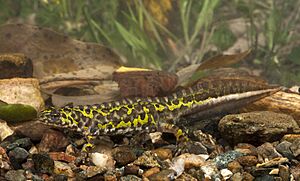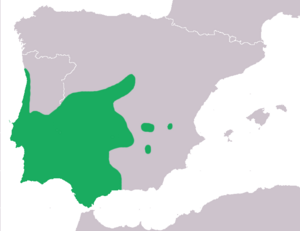Southern marbled newt facts for kids
Quick facts for kids Southern marbled newt |
|
|---|---|
 |
|
| Conservation status | |
| Scientific classification | |
| Genus: |
Triturus
|
| Species: |
pygmaeus
|
 |
|
The southern marbled newt (Triturus pygmaeus), also called the pygmy marbled newt, is a type of salamander. It belongs to the Salamandridae family. You can find this newt in Portugal and Spain.
These newts live in many different places. Their homes include temperate forests and areas with Mediterranean shrubs. They also live near rivers, marshes, and ponds. Sometimes, they are found in farms, gardens, and even ditches. Sadly, their homes are shrinking, which is a big problem for them.
This newt was once thought to be a smaller version of the marbled newt. But scientists studied its genes and found it was a unique species.
Where Southern Marbled Newts Live
The southern marbled newt lives only in southern Portugal. It also lives in southwestern Spain. These areas have a warm, dry Mediterranean climate. The Douro and Tagus rivers form the northern edge of its home. This border separates it from its relative, the marbled newt.
What Southern Marbled Newts Look Like
The southern marbled newt looks a lot like the marbled newt. However, it is smaller. Adult southern marbled newts grow to about 13 centimeters long. The marbled newt can reach up to 17 centimeters.
Their backs are yellowish-green. They have many dark brown or black spots. A thin orange line runs down their spine. This line goes from their head to the tip of their tail. In adult males, this stripe might fade a bit.
Their bellies are creamy-white with dark spots. This is a key way to tell them apart from marbled newts. Marbled newts have dark bellies. When it's breeding season, male newts grow a wavy crest. This crest runs from their head to their tail. It has black bars and no dip between the body and tail.
Protecting Southern Marbled Newts
Southern marbled newts often live in oak woodlands. They use ponds, ditches, and other water bodies for breeding. But their homes are being damaged. Cities are growing, and temporary water bodies are disappearing.
Other dangers include new animals being brought into their habitat. Crayfish and non-native fish can harm them. Pollution at their breeding sites is also a problem. Because of these threats, the International Union for Conservation of Nature says the southern marbled newt is "near threatened". This means they could become endangered soon if things don't change.


